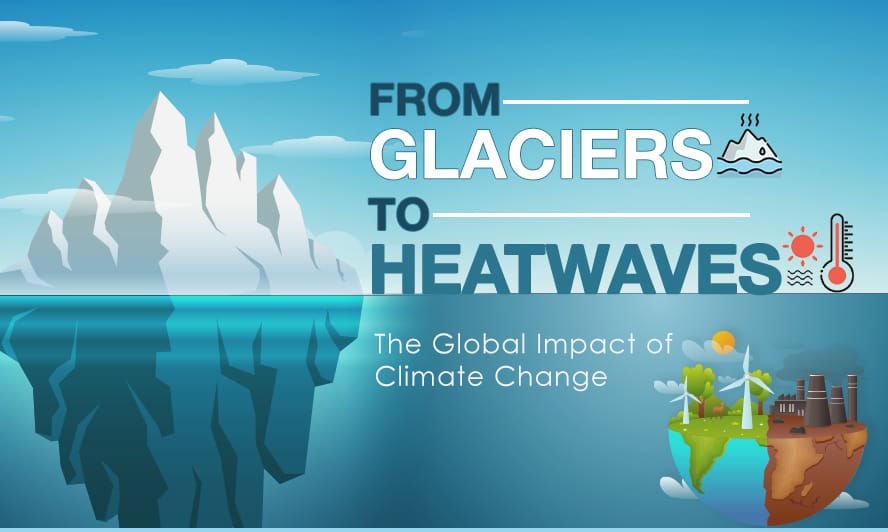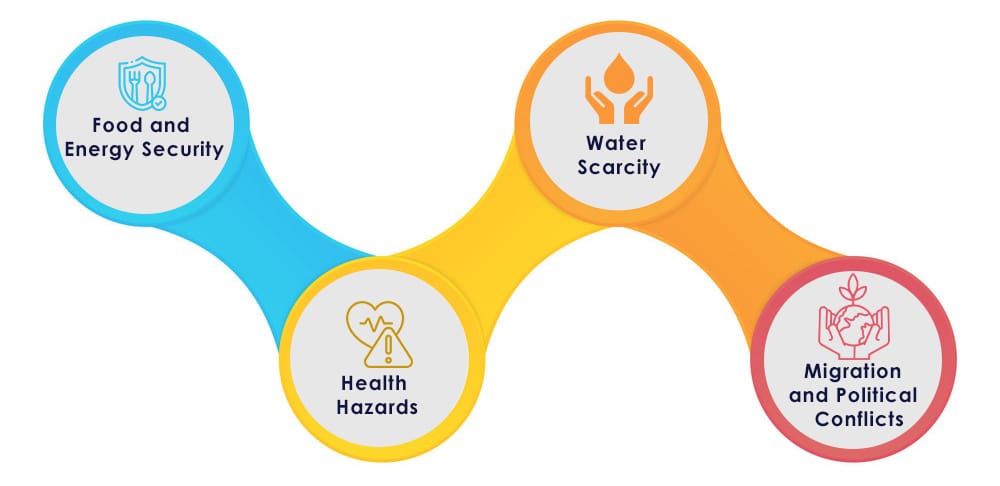From Glaciers to Heatwaves: The Global Impact of Climate Change

By: Kinkini Chakraborty, Shubham Pal, Anurag Bajpai and Shweta Shukla
Long-term scheduled changes in temperature, precipitation, and other atmospheric conditions on Earth are referred to as Climate Change. These changes can occur due to a variety of natural processes as well as human activities. Let's understand it in more detail.
Climate Change
The periodic modification of Earth’s climate results from adverse changes in atmospheric conditions and the interactions between the atmosphere and various geological, chemical, biological, and geographical factors within the Earth's system. It encompasses both natural fluctuations and human-induced impacts on climate patterns.
Components of Climate Change
Natural Factors

- Geological Processes: Events like continental drift, volcanic eruptions, and tectonic activities that alter the Earth's surface and atmospheric conditions over geological timescales.
- Astronomical Factors: Changes in Earth’s orbit, axial tilt, and precession that affect the distribution and intensity of solar energy reaching the Earth, influencing long-term climate patterns.
- Biological Factors: Natural processes involving the biosphere, such as the role of forests in carbon sequestration or the impact of natural methane emissions from wetlands.
Human-Induced Factors (Anthropogenic)

- Greenhouse Gas Emissions: The release of gases such as Carbon Dioxide (CO₂), Methane (CH₄), and Nitrous Oxide (N₂O) from activities like burning fossil fuels, deforestation, and industrial processes. These gases trap heat in the atmosphere, leading to global warming.
- Land-Use Changes: Activities like deforestation, urbanization, and agriculture alter land cover and surface properties, impacting local and global climate. For example, deforestation reduces the number of trees that can absorb CO₂, contributing to higher atmospheric carbon levels.
- Atmospheric Aerosols: Particulate matter from both natural sources (e.g., volcanic ash) and human activities (e.g., industrial pollutants) can influence climate by scattering or absorbing solar radiation and affecting cloud formation.
Climate change is closely linked to the melting of glaciers. As global temperatures rise due to increased greenhouse gas emissions, glaciers around the world are experiencing increased melting resulting in rising sea levels which is having significant impacts on ecosystems, water resources, and weather patterns.
Here's how it works:

Melting Ice and Albedo Effect
The albedo effect, a key concept in climate discussions, manifests in diverse forms such as surface, planetary, and spectral albedo. It's essentially about how well the Earth reflects sunlight, a trait that varies dramatically across different surfaces.
High-albedo surfaces like ice are great reflectors, sending most sunlight back into space, while low-albedo surfaces like oceans absorb more solar energy. This interplay between reflection and absorption significantly shapes global temperatures and feeds into complex feedback loops within our climate system, playing a vital role in the mechanics of climate change and global warming.
When sunlight hits snow and ice, a significant portion of it is reflected back into space because ice and snow have high albedo (reflectivity). Specifically, about 90% of incoming solar radiation is reflected by ice and snow surfaces.
As global temperatures rise, the ice and snow cover diminishes, exposing darker surfaces underneath, such as ocean water or land. These darker surfaces have a lower albedo and absorb more solar radiation. This absorbed energy is then converted into heat, which warms the atmosphere and further accelerates the melting of ice. This creates a self-reinforcing feedback loop:
- Ice melts, exposing darker surfaces
- Darker surfaces absorb more heat, increasing temperatures
- Increased temperatures cause more ice to melt
This feedback loop can lead to accelerated warming and more rapid ice loss, which is a significant concern for climate scientists.
Melting Permafrost and Greenhouse Gas Release
Permafrost is soil that has been frozen for long periods, often tens of thousands of years, found in polar regions. This frozen soil contains large amounts of organic carbon, which includes both plant material and other organic matter.
As temperatures rise, permafrost thaws, releasing these stored organic materials. When these materials decompose, they release greenhouse gases like Carbon Dioxide (CO₂) and Methane (CH₄) into the atmosphere.
- Carbon Dioxide (CO₂): Released from the breakdown of organic matter, contributing to the greenhouse effect.
- Methane (CH₄): Methane is released from decomposing organic matter and is a more potent greenhouse gas than CO₂, with a much higher global warming potential.
The release of these greenhouse gases from thawing permafrost further contributes to global warming, which in turn leads to more permafrost thawing. This, too, is a feedback loop that exacerbates the warming trend.
Sea Level Rise from Melting Ice
The melting of glaciers and ice sheets contributes directly to sea level rise. Here’s how:
- Melting Glaciers: Glaciers are large masses of ice that form on land and flow outward. When they melt, they release freshwater into the oceans, which directly contributes to rising sea levels.
- Ice Sheets: The Greenland Ice Sheet and the West Antarctic Ice Sheet are particularly significant:
- Greenland Ice Sheet: If this ice sheet were to melt completely, it could contribute approximately 6.5 meters (about 21 feet) to global sea level rise.
- West Antarctic Ice Sheet: A complete melt of this ice sheet could lead to a rise of about 8 meters (approximately 26 feet) in sea levels.
Both ice sheets are currently experiencing accelerated melting and instability. As global temperatures rises, these ice sheets are moving faster toward the sea and contributing to the increased sea level.
The potential effects of climate change on India are diverse and significant, impacting various aspects of life, infrastructure, and the environment. Here's an in-depth look at the anticipated effects:
Extreme Heat
- Current Situation: India is already experiencing increased temperatures, with more frequent and severe heatwaves.
- Future Projections: Under a 4°C increase in global temperatures, the west coast and southern India are expected to transition to new, higher temperature regimes. This could have profound impacts on:
- Agriculture: Increased heat stress can reduce crop yields, affecting food security and livelihoods. Certain crops may become unviable in regions that currently support them.
- Public Health: Higher temperatures can lead to heat-related illnesses and deaths, strain energy systems, and exacerbate existing health issues.
Changing Rainfall Patterns
- Historical Trends: Since the 1950s, there has been a noticeable decline in monsoon rainfall.
- Future Projections: A 2°C rise in global temperatures is expected to make India's monsoon more unpredictable. By a 4°C increase:
- Monsoon Intensity: Extremely wet monsoon seasons, which currently occur once in 100 years, could become more common, happening every 10 years.
- Precipitation Extremes: Dry years may become drier, and wet years wetter, leading to increased variability and unpredictability in rainfall.
Droughts
- Current Situation: Droughts have become more frequent and severe since the 1970s, with significant impacts on agriculture.
- Future Projections:
- Increased Frequency: Regions such as north-western India, Jharkhand, Orissa, and Chhattisgarh are expected to experience more frequent and intense droughts.
- Agricultural Impact: Droughts in 1987 and 2002-2003 affected over half of India’s crop area. Future droughts could lead to further declines in crop production and food security.
Groundwater Depletion
- Current Situation: About 15% of India’s groundwater resources are already overexploited.
- Future Projections:
- Decreasing Water Tables: Increased demand for water due to population growth, industrial use, and changing lifestyles is expected to further deplete groundwater resources especially in urban areas.
- Impact on Agriculture: Reduced groundwater availability can impact irrigation practices, exacerbating water scarcity issues for farmers.
Glacier Meltdown
- Current Situation: Himalayan glaciers have been retreating over the past century.
- Future Projections:
- Impact on River Flows: At 2.5°C temperature, continued glacier melting could disrupt the flow of glacier-fed rivers such as the Indus, Ganges, and Brahmaputra.
- Agricultural and Water Supply Impacts: Changes in river flows could affect irrigation in their basins, impacting agricultural productivity and the livelihoods of millions.
Sea Level Rise
- Current Situation: India’s coastal areas are already experiencing impacts from sea level rise.
- Future Projections:
- Higher Sea Levels: Being close to the equator, India may experience significant sea level rise, leading to:
- Saltwater Intrusion: This could impact agriculture, degrade groundwater quality, and contaminate drinking water sources.
- Increased Flooding: Coastal cities like Kolkata and Mumbai are particularly vulnerable to storm surges, flooding, and the combined effects of sea level rise and riverine flooding.
- Health Risks: Increased saltwater intrusion can lead to higher incidences of waterborne diseases such as cholera.
- Higher Sea Levels: Being close to the equator, India may experience significant sea level rise, leading to:
Additional Concerns

- Food and Energy Security: Climate change may affect both food production and energy availability, potentially leading to higher costs and scarcity.
- Water Scarcity: Increased temperatures and changing precipitation patterns could exacerbate existing water scarcity issues.
- Health Hazards: Higher temperatures and changing weather patterns can lead to increased health risks, including heat-related illnesses and vector-borne diseases.
- Migration and Political Conflicts: Environmental stressors such as reduced agricultural output and water scarcity could lead to increased migration and potential conflicts over resources.
Climate change poses a significant threat to India's environment, economy, and society. Rising temperatures, unpredictable monsoon seasons, and increased frequency of extreme weather events will have severe consequences for agriculture, water resources, coastal communities, and public health.
To address these challenges, India needs to be part of a global effort to reduce greenhouse gas emissions and adopt sustainable practices. This includes transitioning to renewable energy sources, improving water management, and developing climate-resilient infrastructure. By taking proactive measures, India can build a more resilient future in the face of climate change.
Contact us:
+91 8076654783, +91 9811122522
[email protected], [email protected]



